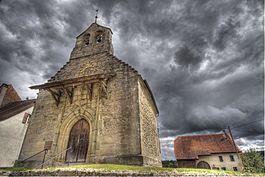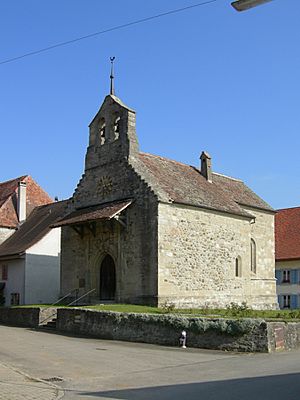Treytorrens facts for kids
Quick facts for kids
Treytorrens
|
||
|---|---|---|

Church of Saint-Jean-Baptiste in Treytorrens
|
||
|
||
| Country | Switzerland | |
| Canton | Vaud | |
| District | Broye-Vully | |
| Area | ||
| • Total | 3.07 km2 (1.19 sq mi) | |
| Elevation | 666 m (2,185 ft) | |
| Population
(Dec 2020 )
|
||
| • Total | 114 | |
| • Density | 37.13/km2 (96.2/sq mi) | |
| Demonym(s) | Les Treytorranais | |
| Postal code |
1538
|
|
| Surrounded by | Champtauroz, Chavannes-le-Chêne, Combremont-le-Grand, Murist (FR), Nuvilly (FR) | |
Treytorrens is a small town, also called a municipality, located in the Vaud area (canton) of Switzerland. It's part of the Broye-Vully region.
Contents
- Exploring Treytorrens: Geography and Land Use
- Understanding the Treytorrens Coat of Arms
- Who Lives in Treytorrens: Population and Demographics
- Important Buildings: Heritage Sites
- How Treytorrens is Governed: Politics
- Working in Treytorrens: Economy and Jobs
- Faith in Treytorrens: Religion
- Learning in Treytorrens: Education
- See also
Exploring Treytorrens: Geography and Land Use
Treytorrens covers an area of about 3.1 square kilometers (1.2 square miles). Most of its land, about 75%, is used for farming. This includes fields for growing crops and pastures for animals.
About 21% of Treytorrens is covered by forests. The remaining 5% has buildings and roads. This means that most of the land in Treytorrens is natural, either for farming or forests.
Before 2006, Treytorrens was part of the Payerne District. Now, it belongs to the newer Broye-Vully District.
Understanding the Treytorrens Coat of Arms
The coat of arms for Treytorrens has a special design. It shows three silver fish swimming on a red background. This design is called Gules, three Fishes nainaint Argent in heraldry terms.
Who Lives in Treytorrens: Population and Demographics
Treytorrens is a small community. As of 2022, it has a population of 124 people. Over the past ten years (1999–2009), the number of people living here has stayed about the same.
Most people in Treytorrens speak French, which is about 95% of the population. A small number of people also speak German or Italian.
In 2000, about 19% of the population were children and teenagers (0–19 years old). Adults (20–64 years old) made up about 62%, and seniors (over 64 years old) were about 20%.
Most households in Treytorrens are families. In 2000, there were 39 private households, with an average of 2.6 people living in each.
The chart below shows how the population of Treytorrens has changed over time:

Important Buildings: Heritage Sites
The Swiss Reformed Church of Saint-Jean-Baptiste is a very important building in Treytorrens. It is listed as a special heritage site of national significance in Switzerland. This means it's a valuable part of the country's history and culture. The entire village of Treytorrens is also recognized as a significant heritage site.
How Treytorrens is Governed: Politics
In the 2007 federal election, the most popular political party in Treytorrens was the SVP. They received almost half of the votes. Other popular parties included the FDP and the PdA Party. About half of the people who could vote actually did vote in that election.
Working in Treytorrens: Economy and Jobs
In 2010, Treytorrens had a very low unemployment rate, meaning almost everyone who wanted a job had one.
Most jobs in Treytorrens are in the primary economic sector, which means farming. In 2008, there were 21 people working in agriculture, and 9 businesses were involved in this area. A few people also worked in the secondary sector, mainly in construction. There were no jobs in the tertiary sector, which includes services like shops or offices.
Many people who live in Treytorrens travel to other towns for work. In 2000, about 12 workers left Treytorrens for every one worker who came into the municipality for a job. Most people used a private car to get to work, while a smaller number used public transportation.
Faith in Treytorrens: Religion
According to the 2000 census, most people in Treytorrens belong to the Swiss Reformed Church, which is a type of Protestant church. About 75% of the population were part of this church.
About 14% of the people were Roman Catholic. A small number of people belonged to other Christian churches. Some people said they had no religious beliefs, and a few did not answer the question.
Learning in Treytorrens: Education
In Treytorrens, many adults have completed a good level of education. About 37% of the population finished upper secondary education, which is like high school. About 12% went on to get a higher education, either at a university or a specialized college.
In 2000, some students living in Treytorrens went to schools in other towns. Also, some students from other municipalities came to school in Treytorrens.
See also
 In Spanish: Treytorrens para niños
In Spanish: Treytorrens para niños





